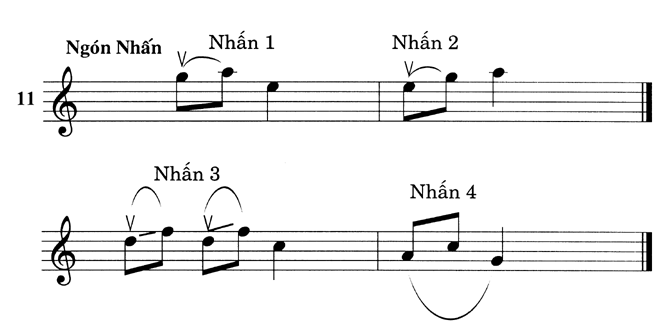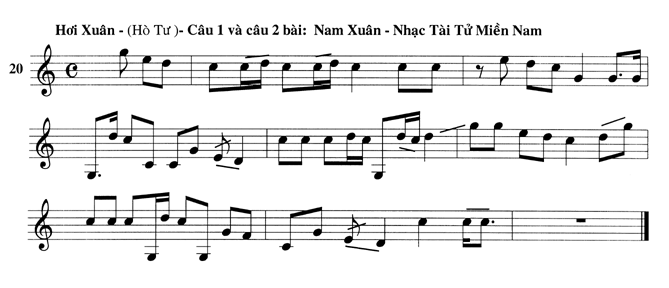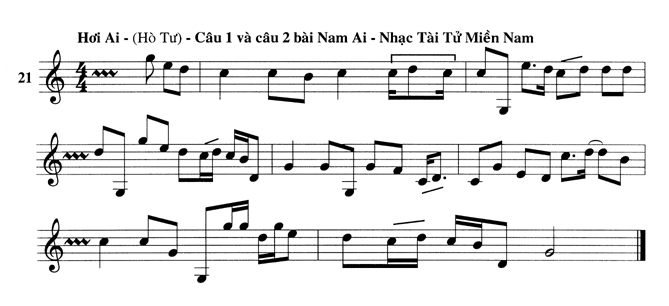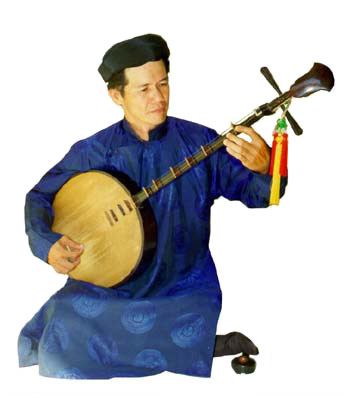
The posture of sitting and the way of plucking: Sitting in low position: players sit on matches with crossed legs. Sitting in straight position: players sit on chairs, putting the lute on their legs white the neck of the lute makes an angle of 60o with their bodies. Standing: players hang the lute on their shoulders with a string.
ư
thế ngồi và cách gảy đàn:Ngồi thấp: xếp chân trên chiếu; Ngồi
thẳng: nghệ nhân đàn ngồi trên ghế, đàn được đặt ngang tầm
tay, cần nghiêng khoảng 60o với thân người; Ðứng: đàn
được đeo vào vai bằng dây, nghệ nhân đàn với tư thế đứng.
Right hand techniques: Plucking: In the past, players made use of their long fingernails to play Nguyệt lute. Nowadays, a plucking plectrum is used instead. Basic movements of the right hand are downwards and upwards strokes. They are denoted as follows:
a.Downward strokes: ^ (up-side-down u denoted above the note)
b.Upward strokes: V (letter V denoted above the note)
In reality, it is unnecessary to denote downward and upward strokes in musical pieces because players usually manipulate these techniques on their own habits. Example: (106-25) Downward strokes (Hò nhứt)
Kỹ thuật tay phải: Gảy đàn: Từ thời xưa, các nghệ sĩ biểu diễn thường nuôi móng tay dài để gảy đàn, ngày nay người ta sử dụng miếng gảy (mediato) để đàn. Ðộng tác cơ bản của tay phải là gảy xuống và hất lên được ký hiệu như sau: a- Gảy xuống: (chữ U ngược trên nốt); b- Hất lên: (chữ V hoa trên nốt). Tuy nhiên thực tế trong các bản nhạc, động tác gảy và hất không nhất thiết phải ghi mà do nghệ sĩ diễn tấu tự xử lý. Ví dụ: (106-25)
Galloping is traditional technique in which players do not use plucking plectrums but make use of all fingers of the right hand. The effect of galloping is similar to tremolo. There are two techniques of galloping.
Ngón phi: ngón phi là lối đánh cổ truyền, nghệ nhân không sử dụng miếng gảy mà sử dụng các ngón tay của bàn tay mặt, hiệu quả của ngón phi gần như ngón vê, có hai lối phi
a- Galloping downward: this is traditional technique in which players often pluck on one or two strings and quickly wag all the fingers, beginning from the little finger or the forefinger and the other ones in turn.
a- Phi xuống: là lối phi cổ truyền thường đánh trên một dây hoặc hai dây, phi xuống là vẩy nhanh các ngón tay, bắt đầu từ ngón út hoặc ngón trỏ rồi lần lượt đến các ngón tay kế tiếp.
b- Galloping upward: players often play on only one string, beginning from the little finger and then the other ones in turn to flip on the string. With galloping technique, players usually use 4 fingers of the right hand; the thumb is not used. If players hold the plucking plectrum with the thumb and the forefinger, they will use only three remaining fingers in galloping technique. Galloping can be used to change the nuance in case the sound feature is on the climax. Example (107-14)
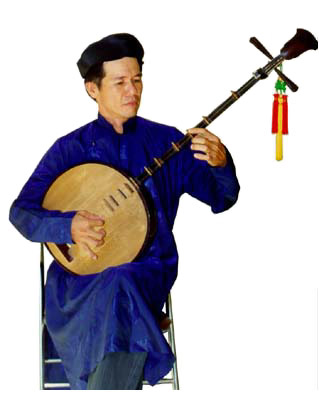 b- Phi lên: thường đánh trên
một dây, bắt đầu từ ngón tay út rồi lần lượt đến các ngón
kế tiếp hất vào dây đàn. Thông thường ngón phi sử dụng 4 ngón
tay của bàn tay mặt, ngón tay cái không sử dụng, nếu nghệ nhân
cầm miếng gảy bằng ngón cái và ngón trỏ, thì trong kỹ thuật
phi chỉ sử dụng 3 ngón tay còn lại. Trong trường hợp nét nhạc
ở cao trào, để thay đổi sắc thái âm thanh có thể sử dụng ngón
phi. Ví dụ (107-14)
Galloping:
b- Phi lên: thường đánh trên
một dây, bắt đầu từ ngón tay út rồi lần lượt đến các ngón
kế tiếp hất vào dây đàn. Thông thường ngón phi sử dụng 4 ngón
tay của bàn tay mặt, ngón tay cái không sử dụng, nếu nghệ nhân
cầm miếng gảy bằng ngón cái và ngón trỏ, thì trong kỹ thuật
phi chỉ sử dụng 3 ngón tay còn lại. Trong trường hợp nét nhạc
ở cao trào, để thay đổi sắc thái âm thanh có thể sử dụng ngón
phi. Ví dụ (107-14)
Galloping:
Tremolo skill refers to downward and upward strokes continuously on the strings. It is usually manipulated in Chầu Văn singing. This skill can be done with a plucking plectrum or by fingers, on one or two strings. Tremolo is manipulated to express exciting or repeat, and can be done on the long vibrated note which is similarly to tremolo skill of Mandoline. Tremolo is denoted by two or three small sloping lines on the top of the stem. Example: (108-6)
Ngón vê: ngón vê là gảy xuống, hất lên liên tiếp lên dây đàn, thường được sử dụng trong Hát Chầu văn, có thể vê bằng miếng gảy hoặc bằng ngón tay và vê trên một dây hoặc hai dây. Ngón vê thể hiện tính chất dồn dập, sôi nổi và có thể vê trên nốt ngân dài hoặc ngắn, giống như kỹ thuật Trémolo của Ðàn Mandoline. Ký hiệu ngón vê: hai hoặc ba gạch chéo trên hoặc dưới nốt nhạc. Ví dụ : (108-6) Tremolo
Ví dụ : (109-5) Downward and upward strokes
Striking: Players use all the fingers of the right hand to strike on the surface of the lute. It is usually manipulated when all the musical instruments are silent or to signal singing, to signal concert performing or between music sentences. Striking is denoted by some crosses above or below the stem. Example: (110-26)
Ngón gõ: sử dụng các ngón tay phải gõ vào mặt đàn, thường được sử dụng trong lúc tất cả các nhạc khí đều nghỉ (dấu lặng) hoặc báo hiệu cho hát, cho hòa tấu hoặc điểm giữa các câu nhạc hay đoạn nhạc. Ký hiệu ngón gõ được các vạch chéo (như dấu nhân). Ví dụ: (110-26)
Pizzicato: In this technique, the note is stopped abruptly as soon as it is sounded causing a change in timbre that could express a choking voice, or could end a music phase. It can create a different effect if it is used continuously. In this case, it can express firming, definitiveness. There are two ways of striking.
a- Players can stop the string with the hand or the finger that has just plucked the strings.
b- Players rest the little finger of the right hand on the string at the bridge to create a dark, damped sound, like using a mute. Striking is denoted by a small dot above the note. Example: (111-15)
Ngón bịt: làm cho âm thanh vừa vang lên liền tắt một cách đột ngột tạo thay sự thay đổi màu âm, ngón bịt diễn tả sự u buồn, nghẹn ngào hoặc để chấm dứt một đoạn nhạc. Nếu sử dụng liên tiếp ngón bịt lại tạo hiệu quả khác: biểu lộ sự cứng rắn, dứt khoát. Có hai cách thể hiện: a-Sử dụng bàn tay hoặc ngón tay vừa gảy chặn ngay dây đàn. b-Sử dụng bàn tay, ở ngang thân ngón út chặn ngang ngựa đàn tạo ra một âm tối, đục tương tự như sử dụng hãm tiếng (Sourdine). Ký hiệu ngón bịt được ghi một chấm nhỏ ngay trên nốt nhạc chỉ âm bịt. Ví dụ (111-15) Pizzicato
Left hand techniques:The Nguyệt lute has eight pressing positions. The fingers are classified as follows: the forefinger is number one; the middle finger is number two; the ring finger is number three and the little finger is number four. With each pressing position, players can use 3 fingers including finger number 1, 2 and 3 (sometimes finger 4 can be used). Each note can be pressed with one finger. However, the distance among either of frets of Nguyệt is a bit large at its head so it is possible for the player to use two fingers on the same fret when manipulating techniques of accent or accent with legato. When pressing, the left fingers of the player always have to be perpendicular with the strings; the tips of the fingers press on the frets.
KỸ THUẬT TAY TRÁI:
Ðàn Nguyệt có tám thế bấm, các ngón được ký hiệu như sau: ngón trỏ: (số 1), ngón giữa: (số 2), ngón áp út: (số 3), và ngón út: (số 4); trong mỗi thế bấm có thể dùng 3 ngón tay (1, 2, 3) để bấm và cả ngón số 4 nữa. Mỗi nốt có thể bấm bằng một ngón, tuy nhiên khoảng cách giữa mỗi phím Ðàn Nguyệt hơi rộng ở đầu đàn nên có thể sử dụng cả hai ngón bấm trên một phím khi thể hiện các kỹ thuật nhấn, nhấn luyến. Khi bấm đàn, ngón tay trái luôn thẳng góc với dây đàn, bấm đầu ngón tay và không gãy ngón.
Vibrato: is to make long vibrating of the lute sound and to soften the high sounds with the aim of making the sound less hard and more sentimental. Open string can also be vibrated by pressing slightly on the string under the tuning pegs. It is up to the players’ techniques that vibrato should or shouldn’t be denoted on the note. Example: (112-7)
Ngón rung: là ngón tạo độ ngân dài của tiếng đàn và làm tiếng đàn mềm đi ở những âm cao, âm thanh đỡ khô khan, tình cảm hơn. Dây buông cũng rung được bằng cách nhấn nhẹ ở đoạn dây sát dưới trục dây (giữa trục dây và sơn khẩu: sơn khẩu là hàng răng để dây đàn chạy luồn qua, đặt ngay ở đầu cần đàn). Ngón rung có thể ghi trên nốt nhạc hoặc không ghi tùy theo sự diễn tấu của nghệ nhân). Ví dụ : (112-7) Vibrato
Accent (Finger Press) is pressing strongly on the string to increase tension and hence the pitch. There are many ways to manipulate this technique.
a- The notes that are not available on the fret system of Nguyệt lute: if players want to have that note, they have to start with the fret whose pitch is immediately below that of the wanted note and press strongly on it to raise the tension of the string at a certain level while the right hand pluck on the string to get that wanted tone. That is called borrowed note technique.Example: (113-27)
Ngón nhấn: ngón nhấn là bấm và ấn mạnh trên dây đàn làm cho tiếng đàn cao lên, có nhiều cách thực hiện ngón nhấn:
a-Các âm không có trong hệ thống cung phím của Ðàn Nguyệt: muốn có âm đó, nghệ nhân phải mượn cung phím có âm thấp hơn âm định đánh, nhấn mạnh ngón tay vào cung phím đó làm dây đàn căng lên một độ nhất định, khi tay phải gảy âm muốn có đó. Cung phím ấy gọi là cung mượn. Ví dụ : (113-27)
b- The notes that are available on the fret system of Nguyệt lute: to make the sound more fluid and sweeter than an open string, players do not press on the main fret but pressing on the fret whose pitch is immediately below that of the wanted note, accent upward then pluck. Example: (114-28)
b-Các âm có sẵn trong hệ thống cung phím: để phát huy hiệu quả diễn tấu nghệ nhân không bấm vào cung phím chính mà bấm vào cung phím thấp hơn, nhấn lên rồi mới gảy. Ví dụ : (114-28) Accent (Hò tư)
Accent with legato is very unique technique of Nguyệt lute and often manipulated. Nguyệt lute has high frets; the distance among either of its frets is a bit large at its head; the strings are made from soft nylon and slack so it is quite possible for players to apply this technique. It can make two notes consecutive and legated in order to alter the pitch from one note to a higher or a lower note. It can help to create a smooth and continuous sound. When applying this technique, the right hand plucks for only one time. Accent with legato is denoted by an arch curving upward or downward from the accented note to the legated note. There are two ways of manipulating this technique.
Ngón nhấn luyến: là ngón độc đáo của Ðàn Nguyệt nên được sử dụng nhiều, Ðàn Nguyệt với phím đàn cao, phím nầy cách phím kia xa, dây đàn bằng nylông mềm mại và chùng nên dễ dàng sử dụng ngón nhấn luyến. Ngón nhấn luyến tạo cho hai âm nối liền nhau, luyến với nhau nghe mềm mại như tiếng nói với nhiều thanh điệu, tình cảm. Khi đánh ngón nhấn luyến tay phải chỉ gảy một lần, ký hiệu ngón nhấn luyến là mũi tên đi vòng lên hay vòng xuống đặt từ nốt nhấn đến nốt được nhấn tới, có hai cách nhấn luyến:
a- Accent with upward legato: players press on a certain fret, the right hand plucks on the string, the sound vibrates while the finger of the left hand that is pressing on that fret manipulating accent causing the tension of the string. Accent with upward legato is from a second to a fourth. To the tone below the neck of the lute – far from the head of the lute, the tone of accent with legato is narrower.
a- Nhấn luyến lên: nghệ nhân bấm một cung phím nào đó, tay phải gảy dây, tiếng đàn ngân lên, ngón tay trái đang bấm cung phím đó lại nhấn xuống cho dây đàn căng lên nhiều hay ít tùy theo ý muốn của nghệ nhân. Ngón nhấn luyến lên có thể trong vòng từ quãng hai đến quãng bốn. Ðối với những âm ở dưới dọc (cần đàn) xa đầu đàn quãng âm nhấn luyến càng hẹp hơn.
b- Accent with downward legato: players press and apply accent on a certain fret and then pluck; while plucking, the finger is gradually slacking but not taking out of the fret in order to keep hearing the second tone (lower than the first tone) just after hearing the first tone. The second tone is not produced by plucking but by applying accent with legato. Accent with upward legato and accent with downward legato should not be applied continuously because it is very difficult to apply correctly. Example: (115-11)
)b-Nhấn luyến xuống: nghệ nhân bấm và nhấn dây ở một phím nào đó rồi mới gảy, vừa gảy ngón tay nới dần ra nhưng không nhấc khỏi cung phím để sau khi nghe âm thứ nhất, còn nghe được âm thanh thứ hai thấp hơn âm thứ nhất. Âm thứ hai nầy không do gảy mà do bấm nhấn luyến xuống, đối với âm luyến lên và âm luyến xuống không nên sử dụng liên tục với nhau vì khó đánh chuẩn xác. Ví dụ : (115-11)
Accent with mordent (press-mordent technique) is pressing continuously on a certain fret. It is up to the emotion of the musical piece that players can press strongly or lightly, quickly or slowly. Similarly, it is up to the length of the note that players can manipulate this technique for a long or short time. The note with accent mordent sounds higher in pitch within a consecutive tone and then returns back to the foundation tone to sound like the voice of the waves. Accent with mordent is denoted by letter M on the arch above the note. Example: (116-29)
Ngón nhún: đây là cách nhấn liên tục trên một cung phím nào đó, nhấn nhiều hay ít, nhanh hoặc chậm tùy theo tính chất tình cảm của đoạn nhạc. Nhấn dài hay ngắn tùy theo trường độ của nốt nhạc, nốt nhấn láy làm cho âm thanh cao lên không quá một cung liền bậc (điệu thức ngũ cung) rồi trở lại độ cao cũ nghe như làn sóng. Ký hiệu nốt nhún: chữ M hoa trên chùm vòng cung đặt trên nốt nhạc. Ví dụ (116-29) Accent with Mordent
This technique is usually manipulated on Nguyệt lute. It can soften the sound and makes it more emotional. With the high tone, the sound of Nguyệt lute is a bit sharp and hard so it is necessary to apply technique of accent combined with mordent for the notes with medium length, without long vibrating, only from one or two beats with medium speed.
Ngón nhún là kỹ thuật thường sử dụng ở Ðàn Nguyệt, ngón nhún làm cho âm thanh mềm hơn, tình cảm hơn. Ở những âm cao tiếng Ðàn Nguyệt hơi đanh, khô nên cần sử dụng kỹ thuật ngón nhún cho những nốt có trường độ vừa phải, không ngân dài, chỉ nên từ một đến hai phách với tốc độ vừa phải.
Mordent: players press on a fret with finger 1 while their right hands pluck on the string. They can tap on the string which is on consecutive fret below its neck with finger 2 or both finger 2 and 3 when the note has just been sounded. This note will be one consecutive fret higher than the main note. The sound of the mordent is a broken, sob-like sound. It can express the feeling of being upset. Mordent is denoted by letter M on the note. Example: (117- 30) Mordent
5-Ngón vỗ: thường dùng ngón 1 bấm cung phím, tay phải gảy đàn, khi âm thanh vừa phát lên sử dụng ngón 2 hoặc cả hai ngón 2 và ngón 3 vỗ vào dây trên cùng một cung phím liền bậc ngay ở dưới cần đàn, âm mới nầy sẽ cao hơn âm chính một cung liền bậc (điệu thức ngũ cung). Âm thanh ngón láy nghe gần như tiếng nấc, diễn tả tình cảm xao xuyến. Ký hiệu ngón láy: chữ "M" đặt trên nốt nhạc. Ví dụ: (117-30)
Accent to get another note: finger 1 of the left hand press on a fret while the right hand pluck on the string; when the sound has just vibrated, players use finger 2 and 3 press strongly on a different fret (usually on higher consecutive fret) and make the sound from this fret vibrates without plucking. This sound can be heard partly because of the vibration of the string and partly because of mordent. This technique creates a weak and soft sound. Being pressed on the high position of the neck, the tone sounds dim so this technique is not manipulated very often. Accent to get another note is denoted similarly to the symbol of legato between the notes. Upwards: means that pressing on the fret of lower note to get the higher one. Example: (118-8)
Ngón chụp: tay trái ngón 1 bấm vào một cung phím, tay phải gảy dây, khi âm thanh vừa phát ra, ngón 2 hoặc 3 bấm mạnh vào cung phím khác (thường là liền bậc cao) âm thanh từ cung phím nầy vang lên mà không phải gảy đàn. Âm luyến nghe được do một phần của dây đàn còn chấn động, một phần do ngón tay mổ vào cung phím tạo thêm chấn động. Âm luyến nghe yếu nhưng mềm mại, ở những thế bấm cao âm luyến nghe kém vang nên ít được sử dụng. Ký hiệu ngón chụp: dùng dấu luyến giữa các nốt nhạc. * lên: là bấm vào cung phím có âm thấp hơn và nhấn lên trên. Ví dụ : (118-8)
Upward Accent Downwards : means that pressing on the fret of higher note and then releasing to get the lower one. Example: (119-9)
* xuống: là bấm vào cung phím có âm cao hơn nhã ra vào âm thấp. Ví dụ : (119-9) Downward Accent
Trill is strengthening the movement of appogiatura to make it quicker in combination with tremolo on the right hand. Trill is denoted by the contraction of the word trill and two small parallel sloping lines on the note. Example: (120-31)
Ngón láy rền: là tăng cường động tác của ngón láy cho nhanh và nhiều hơn với sự phối hợp vê dây của tay phải. Ký hiệu ngón láy rền: sử dụng chữ tắt của trille và hai gạch chéo ở trên hoặc ở dưới nốt nhạc (nếu là nốt tròn) hay trên đuôi nốt nhạc. Ví dụ (120-31) Trill
Pulling skill is pressing on the string as accent combined with legato but the quality of the sound is different; the accented tone just vibrated abruptly stops, The sound of the mordent is similar to hiccough; it can express the feeling of being upset and frustrated. Trill is denoted similarly to that of accent with legato, but the latter note has to be written smaller and with some crosses on the tail. Example: (121-13)
Ngón giật: là cách nhấn trên dây như ngón nhấn luyến nhưng tính chất âm thanh khác: âm được nhấn tới vừa vang lên liền bị tắt ngay một cách đột ngột, âm thanh tiếng giật nghe như tiếng nấc, diễn tả tình cảm day dứt, thương nhớ. Ký hiệu là dùng ký hiệu của ngón nhấn luyến nhưng nốt nhạc sau phải viết nhỏ và có gạch chéo trên đuôi. Ví dụ (121-13) Pulling skill
a- The left hand presses on a certain fret, the right hand pluck on the string, after the sound vibrated, the finger on the left hand which is pressing on the fret abruptly presses strongly to make that sound higher at a certain level.
b- Manipulating similarly, but the left hand is slack just after pressing to return back to foundation tone.
a-Ngón tay trái bấm lên một cung phím, tay phải gảy dây, sau khi phát ra một âm ngón bấm tay trái nhấn mạnh đột ngột làm âm thanh cao lên một độ nào đó.
b-Làm như trên, nhưng sau khi ngón tay trái bấm rồi lại nới ra ngay làm cho âm thanh trở lại như cũ.
Glissando is using left fingers to apply upward or downward glissando along the length of the string while the right hand pluck for only one time or in combination of gallop or tremolo. Glissando is denoted by linking bars between the notes. There are three ways of glissando:
a- upward glissando from the lower to higher notes
b- downward glissando from higher to lower notes. Example: (122-10)
Ngón vuốt: ngón vuốt là dùng ngón tay trái vuốt đi lên hay đi xuống theo chiều dọc của dây trong khi tay phải chỉ gảy một lần hay kết hợp với ngón vê hay ngón phi. Ký hiệu của ngón vuốt là dấu gạch nối giữa các nốt nhạc, có 3 loại vuốt: a-Vuốt lên: vuốt từ âm thấp lên âm cao. b-Vuốt xuống: vuốt từ âm cao xuống một âm thấp. Ví dụ : (122-10) Glissando
Upward glissando Downward glissando
c- Free glissando: There are two ways:
- From a certain note upward (not more than a fifth) to any note.
- From a certain note downward (not more than a fourth) to any note.
The sound of upward glissando is clearer than downward glissando; the sound of quick glissando is clearer than slow glissando.
c-Vuốt tự do: có 2 cách: * Vuốt từ một âm chỉ định lên bất cứ âm nào (thường không quá quãng 5)
* Vuốt từ một âm chỉ định xuống bất cứ âm nào(thường chỉ nên vuốt xuống quãng 4), Vuốt lên âm thanh nghe rõ hơn vuốt xuống, vuốt nhanh âm thanh nghe rõ hơn vuốt chậm.
Staccato: the thumb or the index of the left hand presses on a certain fret white the right hand pluck on the string just below the pressing position to produce sound. Example: (123-32)
Ngón bật dây: tay trái, ngón trỏ hay ngón giữa bấm vào một cung phím nào đó, kế tiếp dùng tay khác gảy vào dây ở ngay dưới ngón tay đang bấm để phát ra âm thanh. Ví dụ : (123-32) Staccato on open string
Staccato on open string: using any finger on the left hand to manipulate staccato on one of the two open strings, or on both strings at the same time. Staccato should only denote in solo performance; it should not be written in a song with high speed or in the note with strong beat. Example: (124-33)
Bật dây buông: sử dụng bất cứ ngón tay trái nào bật một trong hai dây buông, hay cả hai dây một lúc, ngón bật dây chỉ nên viết trong trường hợp độc tấu, không nên đưa vào bài nhạc có tốc độ nhanh hoặc nốt nhạc ở phách mạnh. Ví dụ : (124-33)
Flagiolletto can be played on any strings but should only be played on the middle or lower strings and one octave harmonics are preferred. Players can produce it by laying the left finger on the appropriate spot between the two ends of the strings while the right finger pluck on that string.
Âm bồi: có thể đánh trên tất cả các dây nhưng chỉ nên đánh trong khoảng âm giữa, âm dưới và nên đánh những âm bồi quãng tám. Cách đánh là sử dụng ngón tay trái chặn vào đoạn dây thích hợp kể từ đầu đàn trong khi tay phải gảy dây đó. Ví dụ (125-16)
Ví dụ (126-17)
Ví dụ (127-18)
Ví dụ (128-19)
Ví dụ (129-20)
Ví dụ (130-21)
Ví dụ (131-22)









